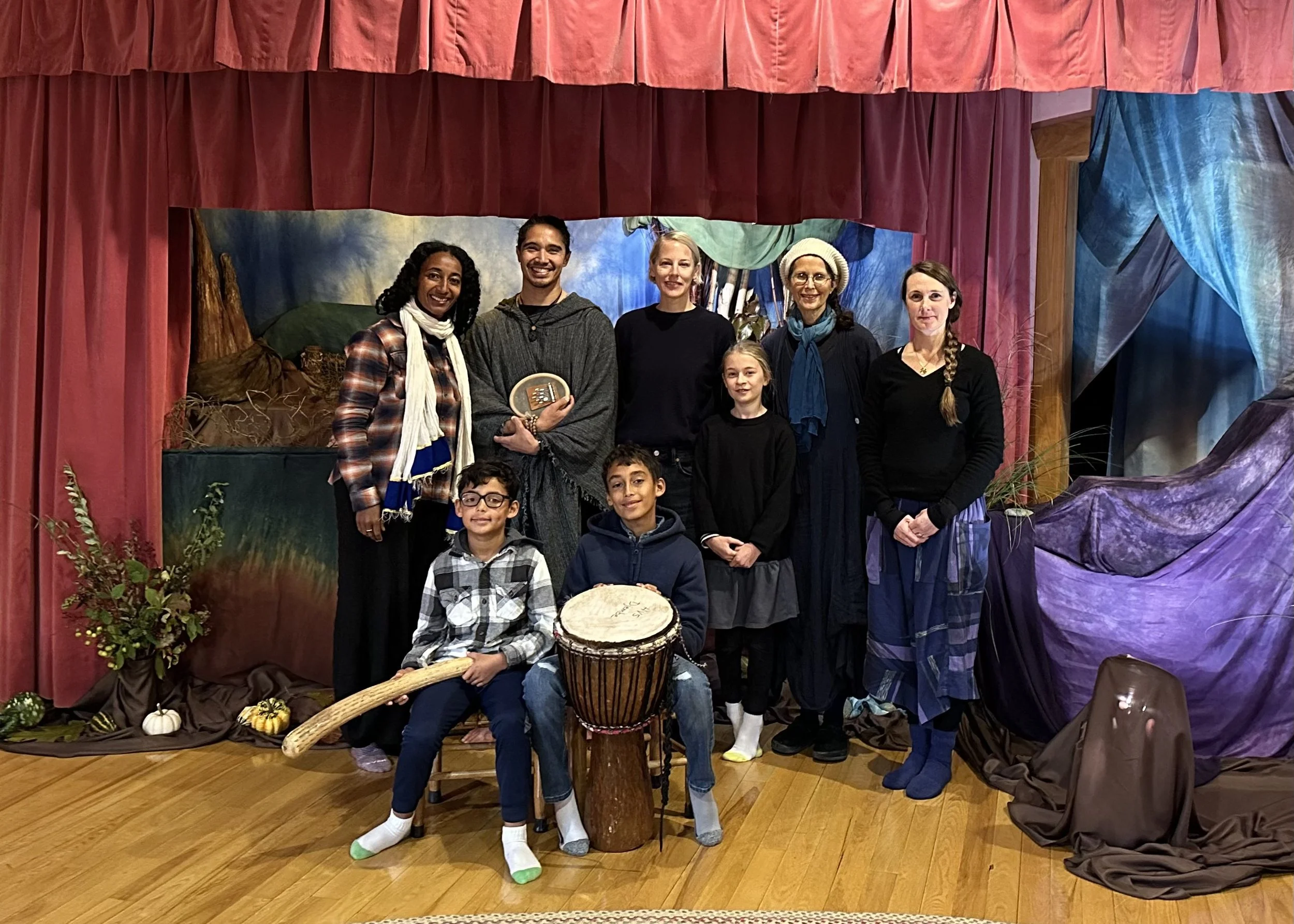Cultivating Attention
Supporting Incarnation Towards Transformation
Janene Ping
There is a story about a Chinese Zen master who was called the Bird’s Nest Monk because he often meditated in a tree. One day an eminent man, who was both a governor and well-known poet, paid him a visit, arriving while he was up in his tree. When the governor found him, he asked, "What is the most important teaching of Buddhism?", and Bird’s Nest recited a verse from the Dhammapada, "Not to commit wrong actions, But to do all good ones, And keep the heart pure, This is the teaching of all Buddhas." When the governor heard this, he was not impressed and said, "Any child of three years knows that." Bird’s Nest said, "Any three-year-old child may know it, but it is difficult for even an eighty-year-old man to achieve.”*
In the above Zen tale, the simplicity of Bird’s Nest’s teaching is profoundly basic. It echoes the foundations of early childhood learning… “We all belong, We take care of each other and our earth, Do what you know is good, not what you know is bad.” How many of our world problems could be solved if we all could achieve these very simple goals! With full disclosure, it may be that, like Bird’s Nest, I will not reveal anything new in this article… but what I am sharing is not easy to accomplish. In seeking to advocate for the protection of childhood and children’s rights, the cultivation of attention and presence is what children, and all of us, really need in order to be whole and healthy in this 21st Century.
Whole and healthy incarnational presence here on this earth requires that we “Be Here Now” in body, soul, and spirit. Loving relationships, immersion in nature, connection to community, work that engages the will, and creative culture are signs of this vibrant presence. As an educator, I have witnessed how all of these are essential for the healthy development of the young child, with love being the first and most important. In this work, the teacher, in serving the child, also needs to tend her own soul life. The creative realms of imagination, inspiration, and intuition offer nourishment for this. Creativity can live within all aspects of life!
As an artist consciously striving to support children’s development, the gifts of storytelling and puppetry arts are close to my heart. Storytelling builds capacities for imagination and empathy; puppetry supports embodiment. The puppeteer must bring attention and intention together to ensoul an inanimate object and bring it to life. A master puppeteer can do this with anything - a wooden bead, the hand… a paper bag… or an ornately carved human figure - whatever the medium, the act of puppetry mirrors children’s healthy play in which the abundantly creative will brings anything and everything to life! In the fulfillment of our own lives, attention and intention are essential keys.
Children have many questions, mostly present but unspoken… Is it safe to come to earth? Am I loved? Am I seen? What does it mean to be human? Their journey of incarnation begins most poignantly at birth. The parent’s loving gaze is like a light that welcomes and validates the child’s being. The way that we as parents, caregivers, and teachers bring our full loving attention towards the child is key in their ability to gain security and develop to the fullest of their ability. Neuroscientist Gabor Mate, in his book Scattered Minds, connects ADD to a deficit of this loving attention in the first three years. Many other research sources have noted the detrimental effects of this kind of neglect. But is not this loving attention needed by us all throughout our lives? It is interesting that we have termed the phrase - to pay attention. Underlying this phrase is the recognition that attention is not only a state of consciousness. In a way, it is a kind of commodity that may be realized or not. Attention is the result of an awakened, focused mind, heart, and will. Attention means that all three of these are aligned in a currency of empowered presence. The state of this currency may look like wealth - or like bankruptcy, a kind of deficit. In truth, attention is one of the greatest gifts we have the capacity to strengthen. Thich Nhat Hanh awakened western society to the term Mindfulness in recognition of our need to raise our consciousness to how the spirit lives in the devotion to each moment. Such is much easier said than done.
There have always been challenges to the cultivation of attention, and our 21st Century has added significantly to these. In The Anxious Generation, Jonathan Haidt documents the overwhelming increase of screens and technology use since 2014 - with the pandemic years having intensified its empowerment in our daily lives, family culture, workplace, and society. While there are benefits to the use of technology, it is also an experience of EXCARNATION - dis-embodiment which is the opposite of what the young child needs for healthy development. The key symptoms of illness that manifest when screens overtake healthy lifestyle lay in the areas of in-person social deprivation, sleep deprivation, attention fragmentation, and addiction.
Throughout the years, I have kept observational notes on children’s development in on-going research about the benefits of play-based and mixed age learning in education. Since the pandemic, I (and every other early childhood teacher that I have spoken with) have seen a significant increase in delayed development, attention/listening difficulties, autistic spectrum patterns in socialization, and behavioral challenges (such as aggression) within the groups of children we are working with. The most disturbing observations are when the child’s imitation of screen programming takes on an obsessive quality of personality displacement - in which a child becomes driven to repeatedly replicate what has been seen in programming and is unreachable as themself - becoming “tuned out” to the people and experiences surrounding them. Yet there is a path of support that can help remediate this! In counseling families I have found significant change in children’s ability to self-regulate and have balanced learning capacities when parents deepen an understanding how to create their own home culture - cultivate attentional presence with their children, connect in meaningful ways with nature and community with true sensory experiences in real place and time.
Humanity needs a renaissance in self-knowledge. Rudolf Steiner understood this. In the beginning basics indications for the young child before the age of 7, there are no barriers between their open sensory intake of the people, environments, and culture that surrounds them. Their learning modality is one of full immersion within sensory experience. Everything that they encounter is programing their sense of self and the world in a deeply subliminal way. Early learning is not usually able to be remembered consciously. It informs neurological patterning and identity within the subconscious for life. Young children do not yet have the capacity for intellectual, abstract concepts. They are growing from the state of being fully PERCEPT towards (hopefully) healthy context for clear CONCEPTS. True and varied sensory experiences of loving presence, nature, and meaningful work form a healthy foundation for later intellectualization.
Waldorf early childhood education seeks to create a healthy context for community life in which parents and children are integral members. Parent support circles, festivals, assemblies, and other gatherings offer rich experiences to inspire friendship, art, celebration, and meaningful activities that nourish family culture. Parents often express that parenting feels like a lonely endeavor - the challenges and joys of raising children in today’s world echo throughout a holographic universe. Individually and collectively, we meet this together. Helping our communities to create healthy culture is so important. Community storytelling and puppetry theaters offer an antidote for the overpowering presence that screens have in our century.
This article may have brought you along on a circuitous journey, but I hope the full circle is rewarding. In very humble ways, the puppeteer and storyteller offer cultural enrichment, in real place and time, in which the exploration of what it means to be human is shared. The art form embraces pedagogical, therapeutic and artistic modalities that offer incarnational support for children of all ages. Community puppetry requires time and devotion, yet it is extremely rewarding to come together with artists, musicians, teachers, parents, and students in the honoring of a good story. When that happens, audiences enter a time out of time in which attention explores what it means to be human, and the spirit of collaborative creativity is celebrated.
Like Helmut von Kugelgen who is quoted below, I am grateful for all fellow puppetry artists who take courage and continue on this path! Together we honor the gifts of the imagination and embrace transformation essential for the times we live in.
“One correctly understands Rudolf Steiner’s efforts for a marionette theater as a “remedy against civilization’s ills” when one sees it in the beginning of a genuine cultural movement around the Waldorf Kindergartens (to bring) independent stages where fairytale theater can reach a growing number of children besides those actually in the kindergartens. This picturesque, educational medium, the living play imbued with inner imagination and fantasy, should be offered in many styles as a way of activating the creative powers of children. The joy and animation of young viewers, who gladly turn their attention and love to the marionettes performing the fairytales develop, in course of a child’s education, into building stones for life.” ~ Helmut von Kugelgen
Book Recommendations:
• The Anxious Generation by Jonathan Haidt
• Who's Raising The Kids? by Susan Linn
• Spoiled Right by Meghan Owenz
• Scattered Minds. by Gabor Maté
• The Child as Sense Organ by Peter Selg
• Kindness: A Treasury of Buddhist Wisdom by Sarah Conover


